Module 5 Unit 3 外研版初中英语八年级下
文档属性
| 名称 | Module 5 Unit 3 外研版初中英语八年级下 | 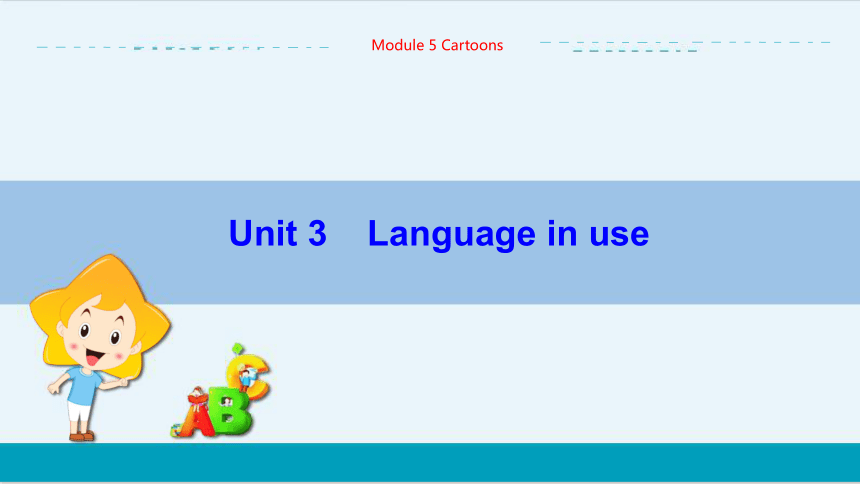 | |
| 格式 | pptx | ||
| 文件大小 | 4.0MB | ||
| 资源类型 | 试卷 | ||
| 版本资源 | 外研版 | ||
| 科目 | 英语 | ||
| 更新时间 | 2024-02-21 19:33:46 | ||
图片预览


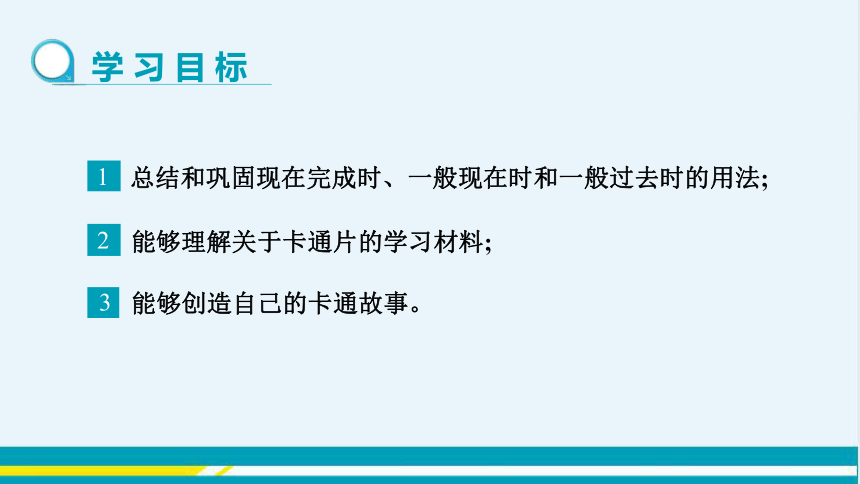
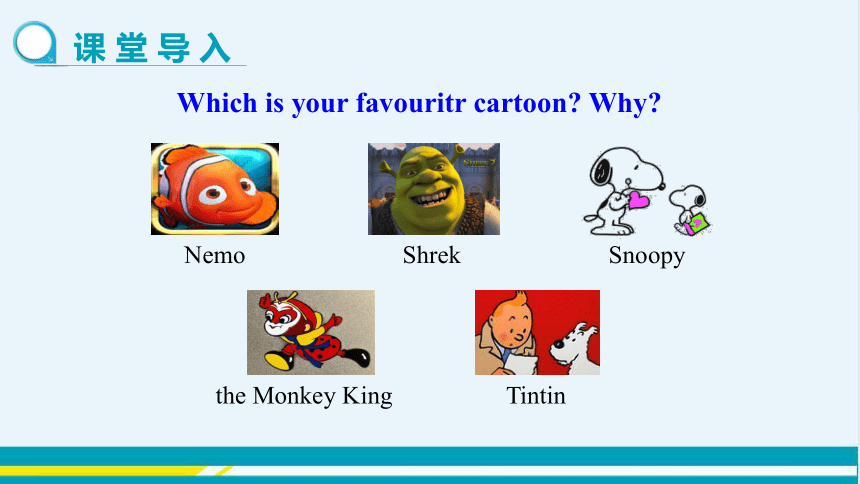
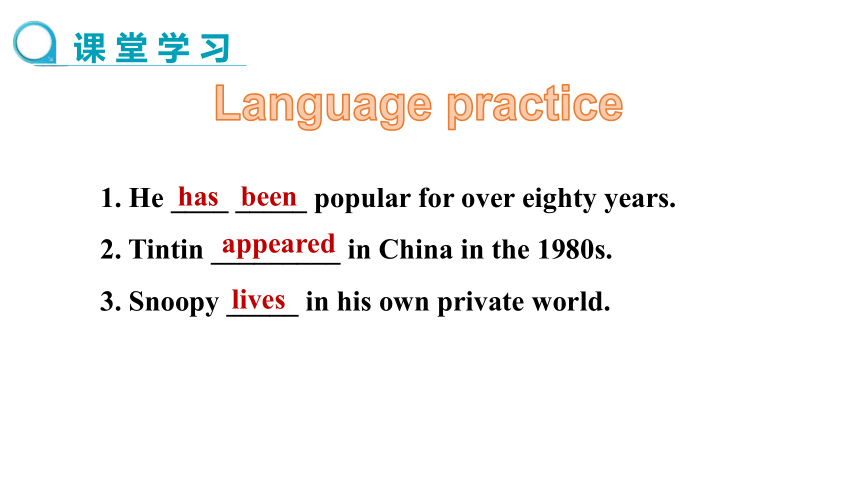
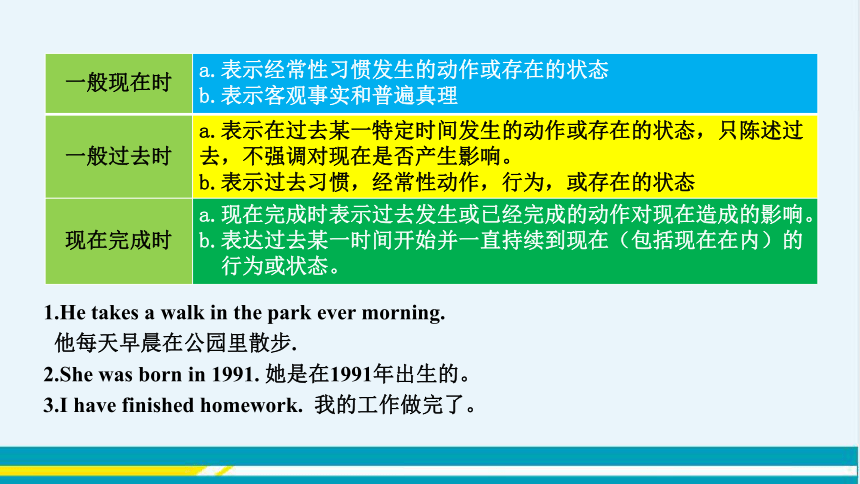

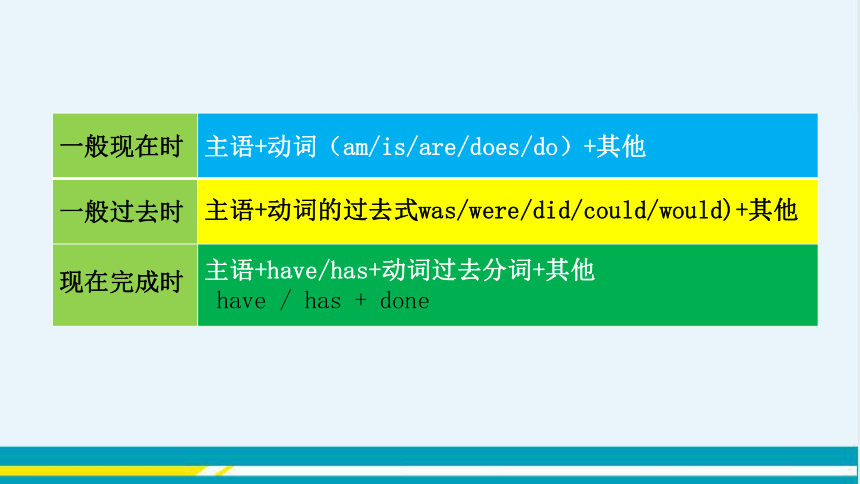

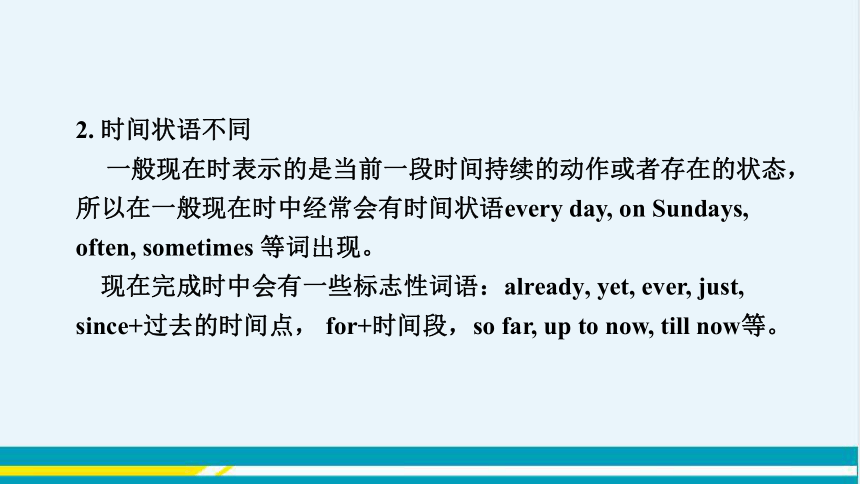

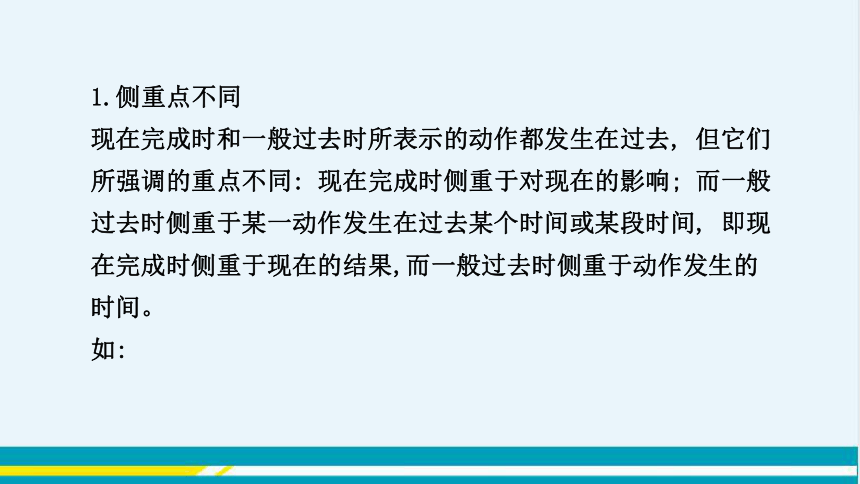
文档简介
(共43张PPT)
Unit 3 Language in use
Module 5 Cartoons
擅长
be good at
向某人要某物
ask sb. for sth.
帮助某人做某事
at first
起初
受到……的欢迎
help sb. do sth.
be popular with
Words and expressions
学 习 目 标
3
能够创造自己的卡通故事。
能够理解关于卡通片的学习材料;
2
1
总结和巩固现在完成时、一般现在时和一般过去时的用法;
课 堂 导 入
Which is your favouritr cartoon Why
Nemo
Shrek
the Monkey King
Snoopy
Tintin
Language practice
1. He ____ _____ popular for over eighty years.
2. Tintin _________ in China in the 1980s.
3. Snoopy _____ in his own private world.
appeared
has been
lives
课 堂 学 习
一般现在时 a.表示经常性习惯发生的动作或存在的状态
b.表示客观事实和普遍真理
一般过去时 a.表示在过去某一特定时间发生的动作或存在的状态,只陈述过去,不强调对现在是否产生影响。
b.表示过去习惯,经常性动作,行为,或存在的状态
现在完成时 a.现在完成时表示过去发生或已经完成的动作对现在造成的影响。
b.表达过去某一时间开始并一直持续到现在(包括现在在内)的
行为或状态。
1.He takes a walk in the park ever morning.
他每天早晨在公园里散步.
2.She was born in 1991. 她是在1991年出生的。
3.I have finished homework. 我的工作做完了。
一般现在时 always,usually,ofen,sometimes,every day,every week,on Sundays,等
一般过去时 yesterday,the day before yesterday,last week,last(year,night,month),in 1989,just now,at the age of 5, one day, long long ago, once upon a time等
现在完成时 recently,lately,since,for,in the past few years等
1.He is ofen late for the meeting. 他常常开会迟到。
2.There was no supermarket in the small town six years ago.
这个小镇六年前没有超市。
3.I've known her for a long time.
我已认识她很长时间了。
一般现在时
主语+动词(am/is/are/does/do)+其他
一般过去时
主语+动词的过去式was/were/did/could/would)+其他
现在完成时
主语+have/has+动词过去分词+其他
have / has + done
1. 用法不同
A: I eat breakfast every morning.
B: I have eaten breakfast this morning.
A句表示过去、现在、未来都要发生的事,这件事是一种习惯或反复。 B句是现在完成时,用于发生在过去的事但对现在仍有影响,或过去的行为一直持续到现在。B句的意思是:我今天早晨吃饭了,表明吃了早饭(可能现在还不饿)。
现在完成时与一般现在时的区别
2. 时间状语不同
一般现在时表示的是当前一段时间持续的动作或者存在的状态,所以在一般现在时中经常会有时间状语every day, on Sundays, often, sometimes 等词出现。
现在完成时中会有一些标志性词语:already, yet, ever, just, since+过去的时间点, for+时间段,so far, up to now, till now等。
现在完成时与一般过去时的区别
现在完成时和一般过去时所表示的动作都是发生在过去, 所以在实际运用中很容易混淆二者的用法。现在我们就一起来看看现在完成时和一般过去时的区别。
侧重点不同
现在完成时和一般过去时所表示的动作都发生在过去, 但它们
所强调的重点不同: 现在完成时侧重于对现在的影响; 而一般
过去时侧重于某一动作发生在过去某个时间或某段时间, 即现
在完成时侧重于现在的结果,而一般过去时侧重于动作发生的
时间。
如:
I have seen the film.
我看过这部电影。(现在我仍记得电影的内容)
I saw the film three days ago.
三天前我看了这部电影。
(强调是三天前,而不是别的什么时候看的电影)
Mr. Green has bought a new computer.
格林先生买了一台新电脑。
(着重点是格林先生现在有了一台新电脑)
Mr. Green bought a new computer yesterday.
格林先生昨天买了一台新电脑。
(强调的是格林先生买新电脑的时间是昨天)
2. 时间状语不同
现在完成时常与already, yet, just, ever, never, before等副词以及“for+段时间”, “since+过去时间/从句”等时间状语连用; 而一般过去时则常与“一段时间+ago”, just now, yesterday, last week等表示过去时间的状语连用。如:
She has lived here since two years ago.她两年前就住在这里了。
She lived here two years ago. 两年前她住在这里。
He has been in the League for three years. 他入团已经三年了。
Tom wrote a letter to his parents last night.昨晚汤姆给他的父母写了封信。
【注意】
句子中如有过去时的时间副词(如yesterday, last week, in 1960)时,不能使用现在完成时,要用过去时。如:
Tom has written a letter to his parents last night. (错)
Tom wrote a letter to his parents last night. (对)
短暂性动词 延续性动词
borrow/lend keep
buy have
die be dead
join be a member of
begin be on
leave be away
come be here
go be there
open be opened
close be closed
常见的短暂性动词和延续性动词的对应表如下:
1. We haven’t heard from Jane for a long time. What do you suppose _______ to her
A. was happening B. happens C. has happened D. happened
2. Hello, I ________ you were in London. How long ________ here
A. don’t know; were you B. hadn’t known; are you
C. haven’t known; are D. didn’t know; have you been
学 以 致 用
C
D
3. I’m glad to tell you that we _____ the work in less time
than we _____ expected to.
A. finished; were B. have finished; are
C. have finished; were D. had finished; were
C
4. When I was at college, I _____ three foreign languages but I ______ all except a few words of each.
A. spoke; had forgotten B. spoke; have forgotten
C. had spoken; had forgotten D. had spoken; have forgotten
B
5. —Look at these stamps. I ____ them for five years.
—Wow, they are wonderful.
A. kept
B. have kept
C. have bought
B
Daming: Hi, Tony. What are you reading
Tony: The Adventures of Tintin. It’s fantastic.
(1)______ you __________(ever read) a Tintin book
Daming: No, I (2)_______________ (never read) a Tintin story.
(3)_____ (be) they popular
Tony: Yes, they (4)__________(be) popular for
more than eighty years. The first Tintin
story (5)__________(appear) in 1929.
Have ever read
have never read
Are
have been
appeared
Complete the conversation with the correct form of the words in brackets.
1
Daming: What does Tintin do
Tony: He (6)_______ (work) for a newspaper and he (7) ______
(have) lots of exciting experiences.
Daming: And (8)_____ the stories ______(have) happy endings
Tony: Oh, yes, they always do.
Daming: Sounds great! Do you mind if I borrow your book
works
has
do
have
Complete the passage with the correct form of
the words in brackets.
When I was young, I (1)___________ (not like) green vegetables. The only vegetable I (2) _____ (eat) was potatoes. I was quite small and not very strong, so I was not very good at sport. Then when I (3)_____________ (watch) television one day I saw the cartoon Popeye. When Popeye stands next to the
didn’t like
ate
was watching
2
bad man, Bluto, he(4)_______ (look) small and weak, and when they fight, he always (5)______ (lose). Then he eats some green vegetables. His arms(6)_______ (grow) thicker. He becomes stronger and he wins his fights. The next day I was going to play football at school, so I asked my mother for some green vegetables. I (7)________ (score) three times and we won the match! I (8)__________ (love) green vegetables ever since.
looks
loses
grow
scored
have loved
Complete the passage with the words in the box.
Many people love cartoons because they are great fun.
Parents and children (1)______ together as the Monkey King makes a terrible (2)_____ or Shrek, the (3)_____ green man, sings a song. Cartoon heroes often live in a(n)(4) ________ world of their (5)_____.Artists (6)_______ good cartoon heroes as well as bad people. The heroes always win,and their stories (7)______ us and help us feel safe.
ugly
mess
laugh
create laugh mess own private satisfy ugly
private
own
create
satisfy
3
Work in pairs and number the pictures in the correct order.
4
Now listen and check.
4
2
3
1
Listen again and answer the questions.
Why does Betty not think the cartoon is funny at first
2 Why does Tony think the cartoon is really clever
Because she does not understand it at first.
Because the policeman could catch the man in the lift, but he doesn’t. They both just stand there, waiting for the lift
to stop!
5
Tony: (laughing) I think this is really funny!
Betty: Why I don't get the joke.
Tony: Look! In the first picture, there's a man running away
from a policeman.
Betty: But why is he running away I don't understand.
Tony: Well, he's done something wrong! The policeman wants
to catch him.
Tapescript
Betty: I see. And then the man runs into the lift.
Tony: Yes, and this is the funny bit. It's really clever!
The policeman could catch the man in the lift, but he doesn't.
They both just stand there, waiting for the lift to stop!
Betty: Now I get it! Yes, it is funny!
Tony: Yes, and as we see in the last picture, the
policeman is still trying to catch the man!
Learning to learn
When you’re listening, do not stop paying attention
when you hear a word you do not know. Keeping
listening.
The word might not be important, or the speaker
may say something to explain its eaning.
Listen to the passage and answer the questions.
1. Where did the first cartoon appear
In newspapers.
2. When did Walt Disney start to make films
In 1920s.
3. Was Micky Mouse Walt Disney’s most famous cartoon
character
Yes, it was.
6
Read the passage and complete the sentences.
1906
1.The first cartoon film
was about _________________.
2. In the film, the faces_______. They____________.
3. A small dog _______
______________.
humorous faces
came to life
smiled
jumped
through a ring
1920s
4. Walt Disney
started to _________in
the 1920s.
make film
5. A Mickey Mouse film was
the first cartoon film ____
_____ to become really
with
sound
popular.
Today and in the future
6. Cartoon films are still popular with_________________.
7. They will probably be popular for__________ years in the future.
people of all ages
many more
Batman and Spiderman are two of the most famous American cartoons. Batman is older than Spiderman. The first Batman cartoon appeared in 1939. Batman is one of the few cartoon heroes to
Classic American cartoons: Batman and Spiderman
appear in books continuously since 1940.
Spiderman was created a lot later. He first appeared in 1962.
In 1977 he appeared in daily newspapers. The Spiderman cartoon
has been seen in over 500 different
newspapers around the world.
People have also made films
based on Batman and
Spiderman.
( )1. Batman is an American cartoon and Spiderman
is an English cartoon.
( )2. Spiderman is older than Batman.
( )3. The first Batman cartoon appeared in 1939.
( )4. Batman appeared in daily newspapers in 1977.
( )5. Now people can see the films based on
Batman and Spiderman.
T
F
T
F
F
阅读Around the world部分,然后判断正(T)误(F)。
Work in groups. Plan your cartoon.
Making a cartoon
Talk about your favourite cartoons and decide on the kinds of cartoon hero you would like to create.
Talk about developing the heroes. What are they like What do they look like What do they do How will they win people’s hearts
Decide who will write the story and who will do the drawings.
Module task:
7
Plan your story. How many different pictures will you need to tell the story
Write the story first and decide how it will be presented with the drawings.
Make some drawings. Use a computer, if you like.
Put the finished drawings and the story together and present them on large pieces of paper.
Show your cartoon to your classmates.
8
Make your cartoon.
9
课 堂 达 标
单项选择
1.Miss Brown, we _____ cleaning our classroom. Can we go home now
A. finish B. finishing C. are finished D. have finished
D
2.-Will you see the film Cinderella with us tonight
-No, I _____ it last week.
A. see B. have seen C. saw
3.-I _____ to the cinema yesterday.
-It’s a pity. You didn’t invite me.
A. go B. went C. have gone
C
B
4.—Lily, why are you still here School is over for half an hour.
—Because I ______ my task yet. I still need one more hour.
A. won’t finish B. didn’t finish C. haven’t finished D. hadn’t finished
5.—Have you ever _______ an amusement park
—Yes, I have. I______ Fun Times Amusement Park last year.
A. been to, have gone to B. gone to, have been to
C. go to, went to D. been to, went to
6.Monica, you ______ the exam! Congratulation!
A.pass B. have passed C. will pass D. are passing
C
D
B
7.—Where is Mr. Zhao
—He ______ to Mount Fanjing. He’ll come back ______ a week.
A. has been; in B. has gone; after C. has gone; in D. has been; after
8.Julia isn’t going to the cinema with us because she _______ the film.
A. sees B. saw C. will see D. has seen
C
D
Homework
2.Review what you have learned in this module and master them by heart.
1.做一份My favorite cartoon为主题的英语手抄报。
Thank you !
Unit 3 Language in use
Module 5 Cartoons
擅长
be good at
向某人要某物
ask sb. for sth.
帮助某人做某事
at first
起初
受到……的欢迎
help sb. do sth.
be popular with
Words and expressions
学 习 目 标
3
能够创造自己的卡通故事。
能够理解关于卡通片的学习材料;
2
1
总结和巩固现在完成时、一般现在时和一般过去时的用法;
课 堂 导 入
Which is your favouritr cartoon Why
Nemo
Shrek
the Monkey King
Snoopy
Tintin
Language practice
1. He ____ _____ popular for over eighty years.
2. Tintin _________ in China in the 1980s.
3. Snoopy _____ in his own private world.
appeared
has been
lives
课 堂 学 习
一般现在时 a.表示经常性习惯发生的动作或存在的状态
b.表示客观事实和普遍真理
一般过去时 a.表示在过去某一特定时间发生的动作或存在的状态,只陈述过去,不强调对现在是否产生影响。
b.表示过去习惯,经常性动作,行为,或存在的状态
现在完成时 a.现在完成时表示过去发生或已经完成的动作对现在造成的影响。
b.表达过去某一时间开始并一直持续到现在(包括现在在内)的
行为或状态。
1.He takes a walk in the park ever morning.
他每天早晨在公园里散步.
2.She was born in 1991. 她是在1991年出生的。
3.I have finished homework. 我的工作做完了。
一般现在时 always,usually,ofen,sometimes,every day,every week,on Sundays,等
一般过去时 yesterday,the day before yesterday,last week,last(year,night,month),in 1989,just now,at the age of 5, one day, long long ago, once upon a time等
现在完成时 recently,lately,since,for,in the past few years等
1.He is ofen late for the meeting. 他常常开会迟到。
2.There was no supermarket in the small town six years ago.
这个小镇六年前没有超市。
3.I've known her for a long time.
我已认识她很长时间了。
一般现在时
主语+动词(am/is/are/does/do)+其他
一般过去时
主语+动词的过去式was/were/did/could/would)+其他
现在完成时
主语+have/has+动词过去分词+其他
have / has + done
1. 用法不同
A: I eat breakfast every morning.
B: I have eaten breakfast this morning.
A句表示过去、现在、未来都要发生的事,这件事是一种习惯或反复。 B句是现在完成时,用于发生在过去的事但对现在仍有影响,或过去的行为一直持续到现在。B句的意思是:我今天早晨吃饭了,表明吃了早饭(可能现在还不饿)。
现在完成时与一般现在时的区别
2. 时间状语不同
一般现在时表示的是当前一段时间持续的动作或者存在的状态,所以在一般现在时中经常会有时间状语every day, on Sundays, often, sometimes 等词出现。
现在完成时中会有一些标志性词语:already, yet, ever, just, since+过去的时间点, for+时间段,so far, up to now, till now等。
现在完成时与一般过去时的区别
现在完成时和一般过去时所表示的动作都是发生在过去, 所以在实际运用中很容易混淆二者的用法。现在我们就一起来看看现在完成时和一般过去时的区别。
侧重点不同
现在完成时和一般过去时所表示的动作都发生在过去, 但它们
所强调的重点不同: 现在完成时侧重于对现在的影响; 而一般
过去时侧重于某一动作发生在过去某个时间或某段时间, 即现
在完成时侧重于现在的结果,而一般过去时侧重于动作发生的
时间。
如:
I have seen the film.
我看过这部电影。(现在我仍记得电影的内容)
I saw the film three days ago.
三天前我看了这部电影。
(强调是三天前,而不是别的什么时候看的电影)
Mr. Green has bought a new computer.
格林先生买了一台新电脑。
(着重点是格林先生现在有了一台新电脑)
Mr. Green bought a new computer yesterday.
格林先生昨天买了一台新电脑。
(强调的是格林先生买新电脑的时间是昨天)
2. 时间状语不同
现在完成时常与already, yet, just, ever, never, before等副词以及“for+段时间”, “since+过去时间/从句”等时间状语连用; 而一般过去时则常与“一段时间+ago”, just now, yesterday, last week等表示过去时间的状语连用。如:
She has lived here since two years ago.她两年前就住在这里了。
She lived here two years ago. 两年前她住在这里。
He has been in the League for three years. 他入团已经三年了。
Tom wrote a letter to his parents last night.昨晚汤姆给他的父母写了封信。
【注意】
句子中如有过去时的时间副词(如yesterday, last week, in 1960)时,不能使用现在完成时,要用过去时。如:
Tom has written a letter to his parents last night. (错)
Tom wrote a letter to his parents last night. (对)
短暂性动词 延续性动词
borrow/lend keep
buy have
die be dead
join be a member of
begin be on
leave be away
come be here
go be there
open be opened
close be closed
常见的短暂性动词和延续性动词的对应表如下:
1. We haven’t heard from Jane for a long time. What do you suppose _______ to her
A. was happening B. happens C. has happened D. happened
2. Hello, I ________ you were in London. How long ________ here
A. don’t know; were you B. hadn’t known; are you
C. haven’t known; are D. didn’t know; have you been
学 以 致 用
C
D
3. I’m glad to tell you that we _____ the work in less time
than we _____ expected to.
A. finished; were B. have finished; are
C. have finished; were D. had finished; were
C
4. When I was at college, I _____ three foreign languages but I ______ all except a few words of each.
A. spoke; had forgotten B. spoke; have forgotten
C. had spoken; had forgotten D. had spoken; have forgotten
B
5. —Look at these stamps. I ____ them for five years.
—Wow, they are wonderful.
A. kept
B. have kept
C. have bought
B
Daming: Hi, Tony. What are you reading
Tony: The Adventures of Tintin. It’s fantastic.
(1)______ you __________(ever read) a Tintin book
Daming: No, I (2)_______________ (never read) a Tintin story.
(3)_____ (be) they popular
Tony: Yes, they (4)__________(be) popular for
more than eighty years. The first Tintin
story (5)__________(appear) in 1929.
Have ever read
have never read
Are
have been
appeared
Complete the conversation with the correct form of the words in brackets.
1
Daming: What does Tintin do
Tony: He (6)_______ (work) for a newspaper and he (7) ______
(have) lots of exciting experiences.
Daming: And (8)_____ the stories ______(have) happy endings
Tony: Oh, yes, they always do.
Daming: Sounds great! Do you mind if I borrow your book
works
has
do
have
Complete the passage with the correct form of
the words in brackets.
When I was young, I (1)___________ (not like) green vegetables. The only vegetable I (2) _____ (eat) was potatoes. I was quite small and not very strong, so I was not very good at sport. Then when I (3)_____________ (watch) television one day I saw the cartoon Popeye. When Popeye stands next to the
didn’t like
ate
was watching
2
bad man, Bluto, he(4)_______ (look) small and weak, and when they fight, he always (5)______ (lose). Then he eats some green vegetables. His arms(6)_______ (grow) thicker. He becomes stronger and he wins his fights. The next day I was going to play football at school, so I asked my mother for some green vegetables. I (7)________ (score) three times and we won the match! I (8)__________ (love) green vegetables ever since.
looks
loses
grow
scored
have loved
Complete the passage with the words in the box.
Many people love cartoons because they are great fun.
Parents and children (1)______ together as the Monkey King makes a terrible (2)_____ or Shrek, the (3)_____ green man, sings a song. Cartoon heroes often live in a(n)(4) ________ world of their (5)_____.Artists (6)_______ good cartoon heroes as well as bad people. The heroes always win,and their stories (7)______ us and help us feel safe.
ugly
mess
laugh
create laugh mess own private satisfy ugly
private
own
create
satisfy
3
Work in pairs and number the pictures in the correct order.
4
Now listen and check.
4
2
3
1
Listen again and answer the questions.
Why does Betty not think the cartoon is funny at first
2 Why does Tony think the cartoon is really clever
Because she does not understand it at first.
Because the policeman could catch the man in the lift, but he doesn’t. They both just stand there, waiting for the lift
to stop!
5
Tony: (laughing) I think this is really funny!
Betty: Why I don't get the joke.
Tony: Look! In the first picture, there's a man running away
from a policeman.
Betty: But why is he running away I don't understand.
Tony: Well, he's done something wrong! The policeman wants
to catch him.
Tapescript
Betty: I see. And then the man runs into the lift.
Tony: Yes, and this is the funny bit. It's really clever!
The policeman could catch the man in the lift, but he doesn't.
They both just stand there, waiting for the lift to stop!
Betty: Now I get it! Yes, it is funny!
Tony: Yes, and as we see in the last picture, the
policeman is still trying to catch the man!
Learning to learn
When you’re listening, do not stop paying attention
when you hear a word you do not know. Keeping
listening.
The word might not be important, or the speaker
may say something to explain its eaning.
Listen to the passage and answer the questions.
1. Where did the first cartoon appear
In newspapers.
2. When did Walt Disney start to make films
In 1920s.
3. Was Micky Mouse Walt Disney’s most famous cartoon
character
Yes, it was.
6
Read the passage and complete the sentences.
1906
1.The first cartoon film
was about _________________.
2. In the film, the faces_______. They____________.
3. A small dog _______
______________.
humorous faces
came to life
smiled
jumped
through a ring
1920s
4. Walt Disney
started to _________in
the 1920s.
make film
5. A Mickey Mouse film was
the first cartoon film ____
_____ to become really
with
sound
popular.
Today and in the future
6. Cartoon films are still popular with_________________.
7. They will probably be popular for__________ years in the future.
people of all ages
many more
Batman and Spiderman are two of the most famous American cartoons. Batman is older than Spiderman. The first Batman cartoon appeared in 1939. Batman is one of the few cartoon heroes to
Classic American cartoons: Batman and Spiderman
appear in books continuously since 1940.
Spiderman was created a lot later. He first appeared in 1962.
In 1977 he appeared in daily newspapers. The Spiderman cartoon
has been seen in over 500 different
newspapers around the world.
People have also made films
based on Batman and
Spiderman.
( )1. Batman is an American cartoon and Spiderman
is an English cartoon.
( )2. Spiderman is older than Batman.
( )3. The first Batman cartoon appeared in 1939.
( )4. Batman appeared in daily newspapers in 1977.
( )5. Now people can see the films based on
Batman and Spiderman.
T
F
T
F
F
阅读Around the world部分,然后判断正(T)误(F)。
Work in groups. Plan your cartoon.
Making a cartoon
Talk about your favourite cartoons and decide on the kinds of cartoon hero you would like to create.
Talk about developing the heroes. What are they like What do they look like What do they do How will they win people’s hearts
Decide who will write the story and who will do the drawings.
Module task:
7
Plan your story. How many different pictures will you need to tell the story
Write the story first and decide how it will be presented with the drawings.
Make some drawings. Use a computer, if you like.
Put the finished drawings and the story together and present them on large pieces of paper.
Show your cartoon to your classmates.
8
Make your cartoon.
9
课 堂 达 标
单项选择
1.Miss Brown, we _____ cleaning our classroom. Can we go home now
A. finish B. finishing C. are finished D. have finished
D
2.-Will you see the film Cinderella with us tonight
-No, I _____ it last week.
A. see B. have seen C. saw
3.-I _____ to the cinema yesterday.
-It’s a pity. You didn’t invite me.
A. go B. went C. have gone
C
B
4.—Lily, why are you still here School is over for half an hour.
—Because I ______ my task yet. I still need one more hour.
A. won’t finish B. didn’t finish C. haven’t finished D. hadn’t finished
5.—Have you ever _______ an amusement park
—Yes, I have. I______ Fun Times Amusement Park last year.
A. been to, have gone to B. gone to, have been to
C. go to, went to D. been to, went to
6.Monica, you ______ the exam! Congratulation!
A.pass B. have passed C. will pass D. are passing
C
D
B
7.—Where is Mr. Zhao
—He ______ to Mount Fanjing. He’ll come back ______ a week.
A. has been; in B. has gone; after C. has gone; in D. has been; after
8.Julia isn’t going to the cinema with us because she _______ the film.
A. sees B. saw C. will see D. has seen
C
D
Homework
2.Review what you have learned in this module and master them by heart.
1.做一份My favorite cartoon为主题的英语手抄报。
Thank you !
同课章节目录
- Module 1 Feelings and impressions
- Unit 1 It smells delicious.
- Unit 2 I feel nervous when I speak Chinese .
- Unit 3 Language in use
- Module 2 Experiences
- Unit 1 I've also entered lots of speaking competi
- Unit 2 They have seen the Pyramids.
- Unit 3 Language in use
- Module 3 Journey to space
- Unit 1 Has it arrived yet?
- Unit 2 We have not found life on any other planet
- Unit 3 Language in use
- Module 4 Seeing the docto
- Unit 1 I haven't done much exercise since I got m
- Unit 2 We have played football for a year now
- Unit 3 Language in use
- Module 5 Cartoons
- Unit 1 It's time to watch a cartoon.
- Unit 2 Tintin has been popular for over eighty yea
- Unit 3 Language in use
- Revision module A
- Module 6 Hobbies
- Unit 1 Do you collect anything ?
- Unit 2 Hobbies can make you grow as a person.
- Unit 3 Language in use
- Module 7 Summer in Los Angeles
- Unit 1 Please write to me and send me some photos
- Unit 2 Fill out a form and come to learn English
- Unit 3 Language in use
- Module 8 Time off
- Unit 1 I can hardly believe we are in the city ce
- Unit 2 We thought somebody was moving about
- Unit 3 Language in use
- Module 9 Friendship
- Unit 1 Could I ask if you've mentioned this to he
- Unit 2 I believe that the world is what you think
- Unit 3 Language in use
- Module 10 On the radio
- Unit 1 I hope that you can join us one day
- Unit 2 It seemed that they were speaking to me in
- Unit 3 Language in use
- Revision module B
